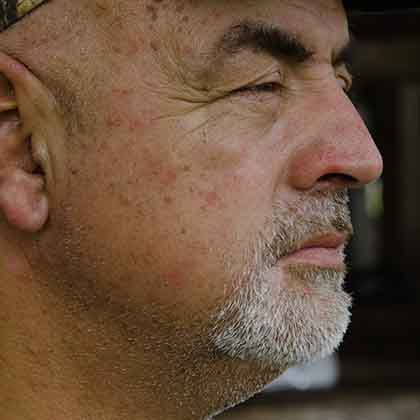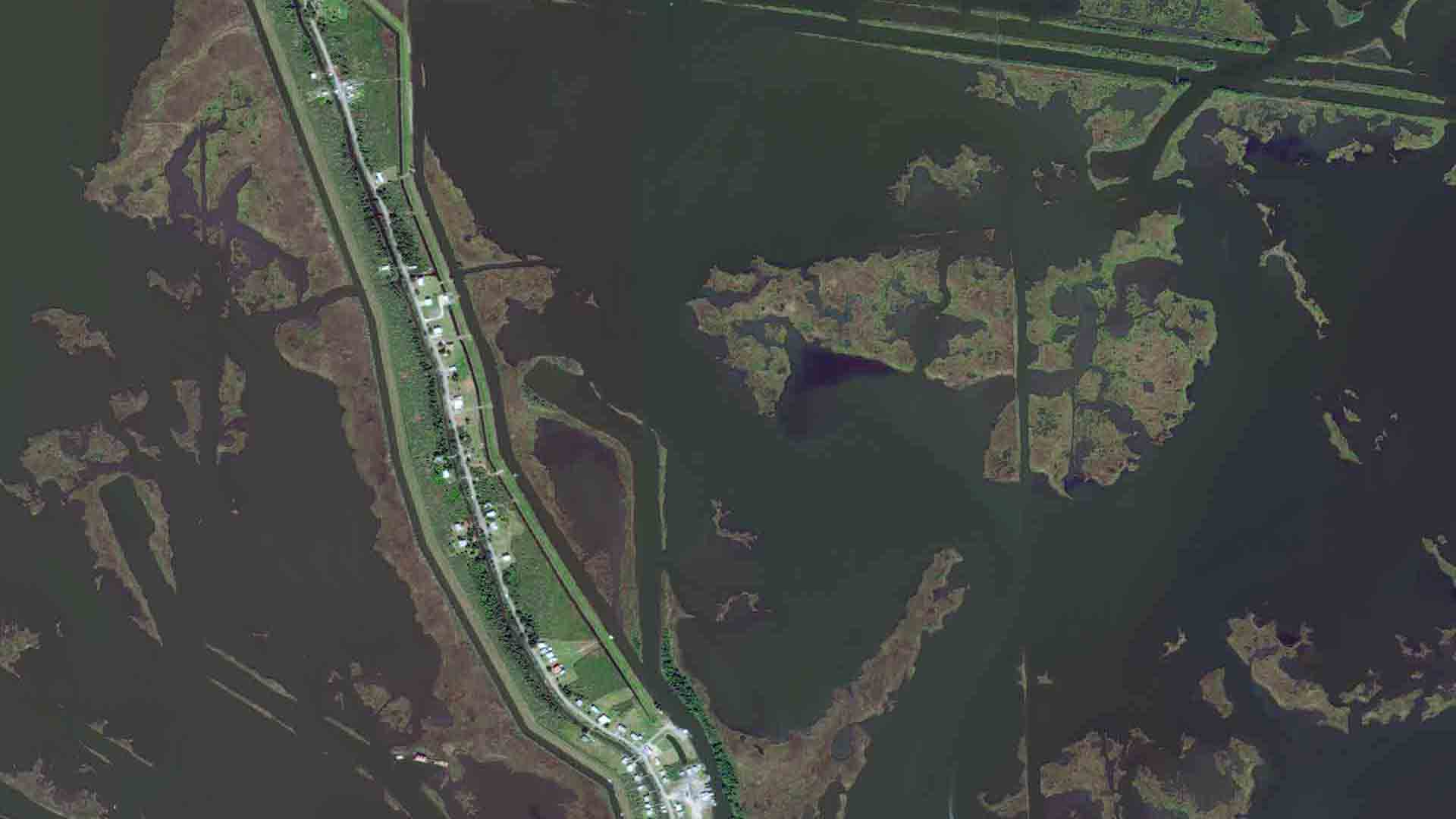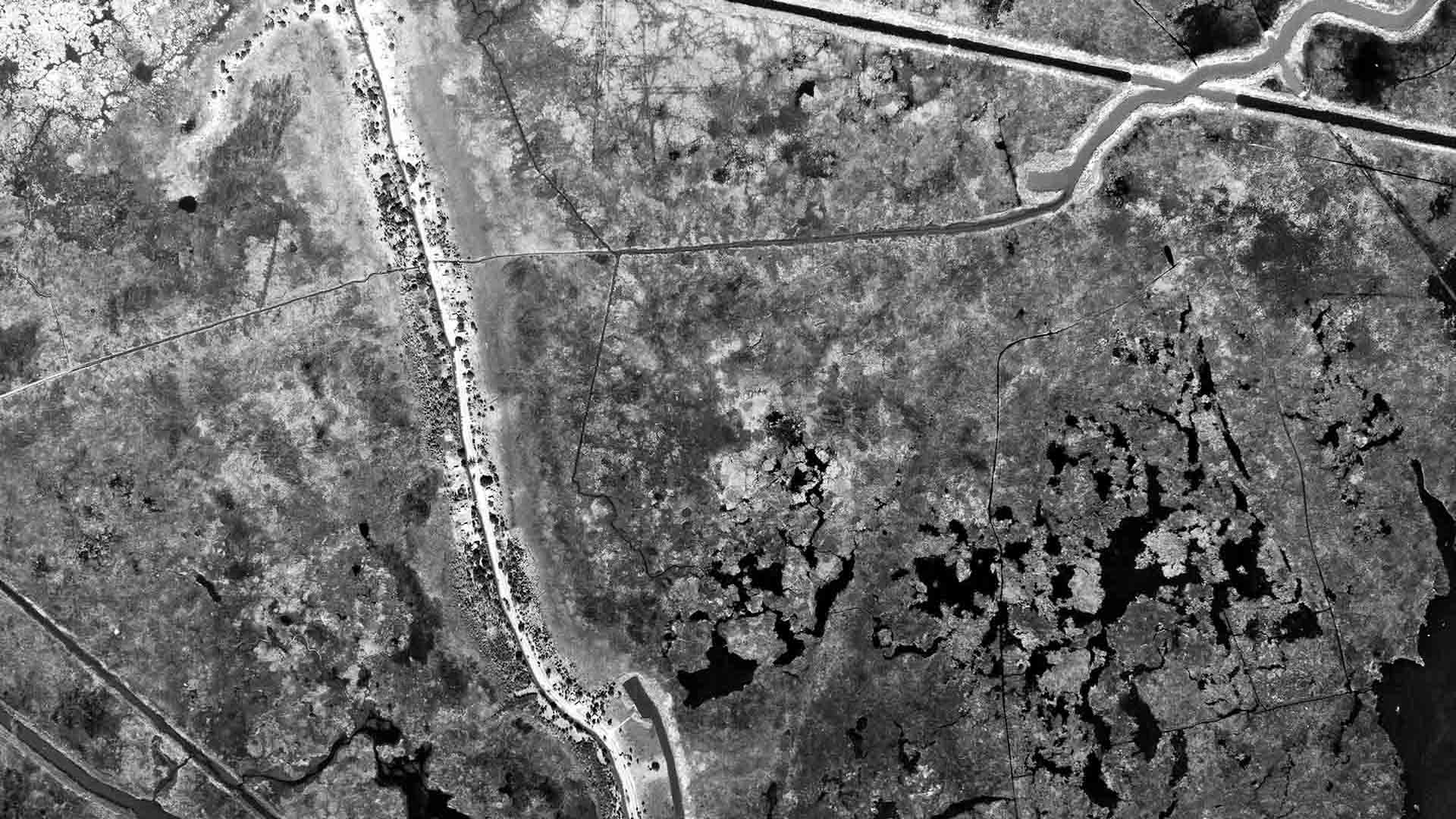Chapter 2
Retreat to Higher Ground
Native American tribe part of first federally funded climate migration
Isle de Jean Charles, La. In a muddy field about 70 kilometers (45 miles) southwest of New Orleans, Chris Brunet’s new home is starting to take shape.
A row of small houses has sprouted in this former sugar cane farm along a wavy road alongside a meandering bayou. Nearly completed structures show off broad front porches and large covered patios. A stubble of cinder block columns mark where others will stand, raised a bit off the lowland ground.
This is no ordinary subdivision, however.
It is the first U.S. federally funded resettlement explicitly aimed at getting people out of the way of the destructive power of climate change.
The Native American residents of an island that in less than a century has nearly entirely eroded into the Gulf of Mexico are getting new houses that will be higher, drier and safer than the ones of their hurricane-prone homeland.
It has been a long time coming. The process has not been easy or smooth. And Brunet is not rejoicing.
“This is not a celebration,” he said. To him, leaving the only home he has ever known is “not even an opportunity. It’s a decision…I really (didn’t) want to make.”

Chris Brunet's home is raised 3.5 meters off the flood-prone ground on the Isle de Jean Charles.
Chris Brunet's home is raised 3.5 meters off the flood-prone ground on the Isle de Jean Charles.

Isle de Jean Charles resident Chris Brunet. (VOA News)

Chris Brunet's house took heavy damage from Hurricane Ida, but he plans to repair it and move back in until his New Isle home is completed. (VOA News)
LEFT: Isle de Jean Charles resident Chris Brunet. (VOA News) RIGHT: Chris Brunet's house took heavy damage from Hurricane Ida, but he plans to repair it and move back in until his New Isle home is completed. (VOA News)
From floods that killed hundreds in China this year to wildfires that wiped out a California town in 2018, climate change is putting more communities at risk. Some places will adapt. But others will be rendered uninhabitable.
Some are preparing for what is known in urban planning circles as “managed retreat” – leaving vulnerable areas before a disaster forces them out.
When news broke of the Isle de Jean Charles resettlement inland in 2016, residents were quickly labeled “climate refugees.”
Residents resent the label. Brunet prefers another name: pioneers.
“Because this here is just an example of some things to come in other places,” he said.
Isle de Jean Charles is disappearing
In 1955, the island covered more than 9,000 hectares (22,400 acres).
Today the island has been whittled down to a 130-hectare (320-acre) ridge, connected to the mainland by a single, 4.5-km ribbon of asphalt that frequently floods.
The land is sinking naturally. Canals cut through the marshes for oil and gas development have hastened the process. And rising seas from climate change are delivering the coup de grâce, experts say.
The loss of land has dealt a blow to the island’s Native American culture. Hunting and trapping grounds are gone, and the encroaching Gulf has made the groundwater too salty to grow vegetables and plants for traditional medicine.
The disappearing land is bad enough. But the land also used to absorb the brunt of tropical storms that regularly batter the Gulf coast.

Erosion, subsidence and climate change-induced sea level rise have whittled Isle de Jean Charles down to a thin strip of land. (VOA News)
Brunet has weathered many storms and was prepared to weather more.
“Living on the bayou, hurricanes are part of that environment. You don’t want it to happen, but you do know they will,” Brunet noted.
It’s the erosion that is driving him from his home, he said.
“Since there’s more water than land, then even a smaller storm can do more damage.”
It’s a big problem all along Louisiana’s coast. The Gulf consumes roughly a football field-sized chunk of land every 100 minutes on average, according to a 2017 U.S. Geological Survey estimate.
As climate change speeds up sea level rise and makes storms more intense, the state is not the only one threatened.
“We know that we’ve got a lot of communities in coastal Louisiana (and) there are a lot of communities around the country that are being faced with the same prospects,” said Pat Forbes, executive director of the state Office of Community Development.

“We’ve got a lot of communities ... around the country that are being faced with the same prospects” from climate change as Isle de Jean Charles, said Louisiana Office of Community Development chief Pat Forbes. (VOA News)
More to come
That’s why in 2014, the U.S. Department of Housing and Urban Development awarded Louisiana $48.3 million to relocate the residents of Isle de Jean Charles.
“HUD wanted us to do something that helps all of us learn how to do this better,” Forbes added, “because there’s going to be a lot of it.”
The development is unprecedented in other ways, not only for Louisiana, but for the United States, Forbes noted.
“Usually, disaster recovery…funds are spent to go build back what got whacked,” he said. “All we’ve ever done in the past, for the most part, is give people money to go find a house somewhere. And when you do that, the whole community falls apart, spreads out all over the place.”
“This is the first time that we have moved an entire community en masse to a new community created just for them,” he added.
Maintaining the community was especially important for the Biloxi-Chitimacha-Choctaw Native Americans who call Isle de Jean Charles home.
When the U.S. government forcibly resettled Native American tribes to Oklahoma in the mid-1800s along what became known as the Trail of Tears, some fled to the remote coastal wetlands of southern Louisiana. White Americans considered these areas uninhabitable. Unique Native cultures developed in isolation.
“You can’t replace that,” Forbes said. “And that has real value to it.”

Isle de Jean Charles tribal chief Albert Naquin argued for relocation for two decades. But the state's plans are not what he had in mind. (VOA News)
Reuniting the tribe
Getting to this point has been a 20-year struggle.
In the early 2000s, the U.S. Army Corps of Engineers determined that it would cost too much to include Isle de Jean Charles in a proposed hurricane-protection levee system.
According to the island tribe’s chief, Albert Naquin, officials asked him if the tribe had considered relocation.
“I said, no way,” he told VOA. “That’s just a modern-day Trail of Tears.”
But Naquin changed his mind. When these discussions were happening, Naquin himself had already moved off the island. He recognized he did not have to deal with the storm damage that residents suffered regularly.
“If I stayed on the island, I would just be as poor as them,” Naquin noted. “Every so many years, you have to replace all your appliances and repair your home. You can’t get ahead.”
Most people had made the same decision. The island’s population shrunk from around 400 to fewer than 100. Many of those who stayed didn’t have the means to leave.
Relocation offered an opportunity not only to get the remaining residents out of harm’s way, but also to reunite the tribe.
“We want the people from the island and all those that moved off the island to be all put together in one place again,” he said.
So, Naquin started working with the Army Corps of Engineers on resettlement plans.
It did not go well.
Naquin said a vocal minority strongly objected to leaving. Public meetings were acrimonious. Plans fell through. Naquin tried again after Hurricanes Gustav and Ike in 2008 flooded the island again. But again, rancor sank the plans.
Things finally came together in 2014, when the state of Louisiana entered several projects into HUD’s $1 billion national competition aimed at making disaster-struck communities more resilient in the face of climate change.
“We knew that proposing a resettlement project would be one of those,” Forbes said. “We were aware that Isle de Jean Charles has been in an increasingly dangerous position for years and that they had, in fact, started to look for ways to get the community moved. So, we talked to them about the possibility of working together.”
The state won a $92.6 million grant, about half of which went to the Isle de Jean Charles resettlement.
The island residents chose a 208-hectare (515-acre) former sugar cane plantation about 55 km (35 miles) inland. They named it New Isle.
It wasn’t the prettiest of the sites, Brunet said. But it was the highest.
“If you’re going to make a move, make it right,” he added.
‘A matter of fairness’
But plans took another turn.
Naquin and the Biloxi-Chitimacha-Choctaw tribe had spent years shaping the resettlement proposal, aiming to bring their people back together. Not everyone on the island was from the same tribe, however.
The state offered resettlement to everyone who lived on the island when Hurricane Isaac hit in 2012, regardless of tribal affiliation.
Naquin was furious.
“The state of Louisiana did what they wanted and not what the tribe wanted,” he said. “It was a tribe resettlement. Now, it’s just the island people.”
“It’s just a matter of fairness,” Forbes countered. The state could not relocate one ethnic group exclusively. That’s against the Fair Housing Act. It’s against any moral ideas that any of us has, and we would never want to do that.”
Naquin no longer supports the project. He does not plan to leave his current home, a few kilometers from the island.
But most island residents decided to relocate anyway.
Brunet’s house is one of 37 the state is building at New Isle for island residents. Another 41 families who left the island have applied for lots.
While his island home stands 3.5 meters (11.5 feet) in the air on stilts, New Isle homes are just a few cinder blocks off the ground. They are constructed according to building codes that reduce damage from severe weather.
With the island getting more and more vulnerable, Brunet said it was better to act before the next big storm forced their hand.
“We didn’t have to wait for that apocalyptic moment where everything would have been a rush,” he said. This way, he added, residents have had a hand in choosing the site, designing the homes and other key decisions.
But Brunet is not looking forward to the move.
“It will be a good while before that house that they are building me will be my home,” he said. “It’s not because I want to be hardheaded or I want to complain. But that’s just who I am. Because I’m so rooted on Isle de Jean Charles. This is where I’m from.”

Pat Forbes and Chris Brunet visit the New Isle construction site in July 2021. (VOA News)
Lessons learned
For a problem that is expected to grow with climate change, experts still have a lot to learn about how to handle climate migration, according to a July 2020 U.S. Government Accountability Office report.
Existing programs are not designed for this new threat, it said, and no federal agency is in charge.
“I think the first and most profound lesson … is that the process is complex, messy, and that there is no recipe that can be used for all situations,” said Craig Colten, a professor emeritus of anthropology and geography professor at Louisiana State University and adviser to the Isle de Jean Charles project. “There needs to be considerable effort to engage community members in shaping the plan. This will demand even more lead time than some might assume.”
It’s not easy, but it’s the right move to transplant communities whole, he added.
“Community, culture and kinship are as important to most as safety,” Colten said.
Meanwhile, as construction crews were preparing New Isle, developments on Isle de Jean Charles reopened old wounds.

New fishing piers and a rock barrier were built on the sole road to the island as residents prepare to relocate. (VOA News)
The Louisiana Department of Wildlife and Fisheries built new fishing piers along the sole road leading to the island. And the parish government built a rock wall to protect the road.
Meanwhile, private landowners on the island made plans to sell their property to fishing-camp owners.
Local Native Americans saw it as a plan to get rid of them to make way for wealthier white landowners.
“They couldn’t fix the road for the Indians,” Naquin said. “Now, they’re going to fix the road for the sport fishermen.”
“Yeah, it looks bad,” said Colten, the adviser to the Isle de Jean Charles project.
He said there is no malicious intent behind the projects, though. The state wildlife agency built the fishing piers with funds from the BP Deepwater Horizon oil spill settlement. But the actions come at an awkward time.
He understands why the island’s Native American residents “feel horribly shortchanged.” After centuries of mistreatment by white Americans, the latest events feel like a pattern repeating itself. In their view, it’s “‘just like in the old days. We sign a treaty, and we give our land away, and we get the short end of the stick,’” Colten said.
Then in August, Hurricane Ida scored a bull’s-eye on Isle de Jean Charles.
The Category 4 storm wrecked part of Brunet’s house and ripped off a swath of the roof.
It could have been worse. Most houses on the island were shredded. Had the island taken the brunt of the 3-to-4.5-meter (10-to 15-foot) storm surge, Brunet said it would have been game over for his house, too.
It will be next year before his new house in New Isle is ready. Most of the other families who will be relocating there are currently living elsewhere in state-funded rentals. But Brunet plans to stay on Isle de Jean Charles until the very end.
“I’m going to repair the damages that my home received from Hurricane Ida and get back inside my house. No matter how long it takes,” he said.
The reason is simple.
“I’m coming back home,” he said, “because that is home.”

